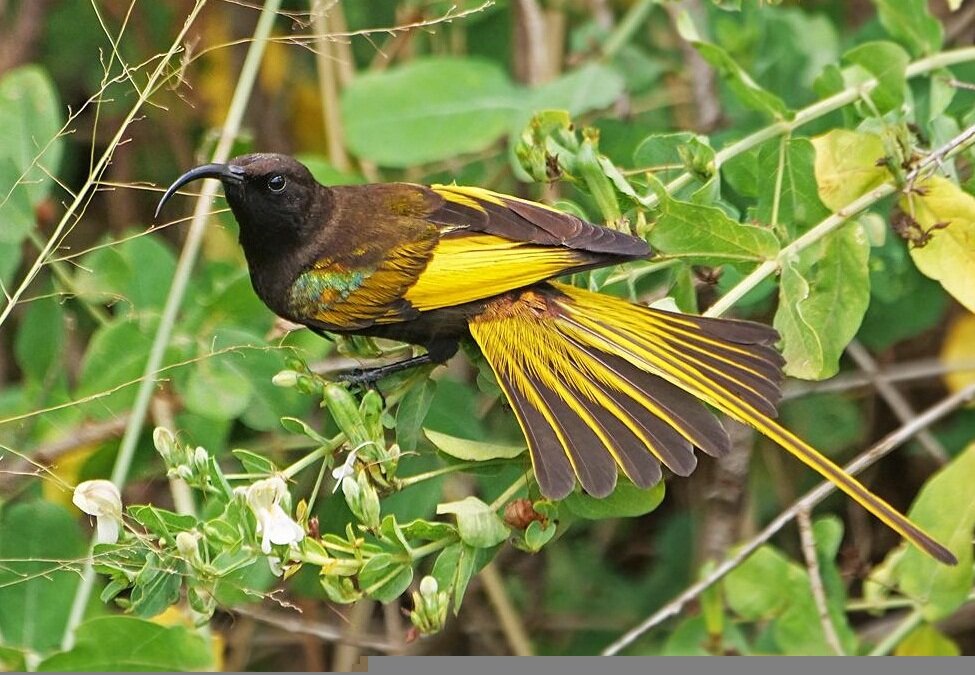Birding in Uganda
Uganda is the best destination in Africa to do birding. Over 1050 bird species which are being inhabited in different habitats across the country like in semi-arid areas, rich savannah, lowlands, montane rainforests, vast wetlands, volcanoes, Afro-alpine zone, agricultural land, rivers, and lakes. All these habitats are accessible for birding because the government of Uganda realized the importance of tourism and improved on the transport system linking up to these various areas. When you visit Uganda for bird watching you will have more chances of seeing a variety of bird species due to more birds per square kilometer than any other country in Africa.
Top 10 birding destinations in Uganda
Mabamba wetland on Lake Victoria
This wetland is located at the edge of Lake Victoria, west of Entebbe peninsula 36 km in Mpigi district away from Kampala city which is the country’s main capital.
It is one of the best marshy areas along the northern shores of Lake Victoria for bird watching boasting of over 260 bird species with one day’s record of 157 bird species. The wide variety of bird species comprises of the rare shoebill which can be spotted at any time of the day, the migrant blue swallow, Pallid harrier, Papyrus gonolek, white-winged warbler, swamp flycatcher, malachite kingfisher, African jacana, Lesser jacana, winding cisticola, grosbeak weaver, African marsh harrier, and many others.
It should be remembered that Mabamba is one of Uganda’s 33 Important Bird Areas.
Bwindi impenetrable national park
This park is located in southwestern Uganda is well known for inhabiting the rare endangered mountain gorillas. It’s a beautiful place with mountains and valleys covered by the tropical rainforest which is green throughout the year. The vegetation covers both the mountains and the valleys.
This forest is one of the rich biologically forests in Africa with a variety of about 350 bird species, for example, the Albertine rift endemics of which 14 can’t be found anywhere in Africa. It was also voted as Africa’s best birding spot by the African bird club.
The forest has well-maintained birding trails that give you chances to see a variety of birds like African green broadbill, Fraser’s eagle, collared Apalis, handsome francolin, western bronze-napped pigeon, blue-headed and regal sunbirds among many others.
Murchison Falls National Park
This park is located at the northern end of the western arm of the Albertine rift valley. It is the oldest and biggest national park in Uganda bisected by part of the longest river in the world the mighty Nile forming the northern and the southern bank. The course of river Nile plunges 45m over the remnant rift valley wall into a narrow gorge of 7m forming the most powerful waterfalls in the world. This park has a variety of habitats like the savannah, Borassus palms, acacia trees and riverine woodland, woodlands and forest patches, especially in the southern bank.
This park is one of the best birding spots in Africa because of its various habitats act as homes to 451 bird species found within this park and it takes the 9th position in Africa when it comes to birding. Birding in this park can be done both on a game drive and launch trips and expect to see savannah forest birds, Albertine rift endemics and water birds. Some of the birds to look out are elusive shoebill stork, goliath heron, swamp flycatcher, Abyssinian ground hornbill, giant kingfishers, malachite and many others.
Queen Elizabeth National Park
This park is located in the western parts of Uganda and is one of the most popular and scenic. It has a variety of ecosystems like open savannahs, rainforests, dense papyrus swamps, brooding crater lakes, and humid forests. This park is endowed with a variety of big game, 600 bird species and 10 primates offering a lot to the Queen Elizabeth national park itinerary.
Queen Elizabeth national park is a birder’s haven with a wide variety of bird species which are relatively easily seen. Some of the birds to look out are African mourning dove, swamp flycatcher, malachite, African skimmer, grey capped warbler, black-headed gonolek, sedge warbler, papyrus canary, flamingos at the salt lakes of Katwe among many others.
The park’s savannah and forests linkup with the big forests of Democratic Republic of Congo giving our clients to view both the east and the central African bird species namely African darter, long-tailed cormorant, little egret, hammer kop, European honey buzzard, knob-billed duck, northern pintail, Egyptian goose, scissor-tailed kite, black-crowned crane, common snipe, rose winged parakeet, standard winged nightjar, brown nightjar, African pitta, African yellow-warbler among others.
This park has the greatest bird species in East African national parks and it was recognized as the “International Birding Area” by Birding International.
Queen Elizabeth National Park features other attractions which are amazing to see like the crater lakes, panoramic views of the Kazinga channel with its river banks occupied with the hippos, buffalos, elephants, and many other wild animals. The Ishasha sector of the park has tree-climbing lions that hide in the fig trees because of the excessive heat on the rounding day time and pests.
Mgahinga Gorilla National Park
Mgahinga Gorilla National Park is located in the extreme western corner of Uganda forming part of the Virunga conservation area covering an area of 434 kilometers squared which comprises Mgahinga Gorilla National Park in Uganda, Volcanoes National Park in Rwanda and Virunga in the Democratic Republic of Congo.
Mgahinga has about 180 bird species with some of the Albertine rift endemics, .14 of the 24 bird species are of the Albertine rift valley mountain endemics and 39 of the 88 bird species are of Afro-tropical highlands biome that occurs in Uganda.
The park offers excellent viewing spots like along the gorge trail, bamboo trial, farm trails. Look out for birds like cape robin, Kivu ground thrush, cinnamon bracken warbler, white starred robin, western green tinker bird, strip- breasted tit, scarlet tufted and many others.
Semuliki National Park
Semuliki national park is located in southwestern Uganda within the Albertine rift valley. It’s one of the best birding destinations within Uganda boosting of 441 bird species in both the riverine forest and grassland avian ecosystems.
The park has a variety of birds like the 46 Guinea-Congo biome bird species which reach Uganda through the Congo basin vegetation stretching from Lake Albert to Congo area and the 5 Albertine rift endemic species. Birds to look out in Semuliki National Park include Congo serpent eagle, long-tailed hawk, Nkulega rail, black wattled hornbill, black-winged starling, white-tailed hornbill, capuchin babbler, crested flycatcher, orange weaver, red-billed malimbe and many others.
Rwenzori National Park
Rwenzori is Africa’s most beautiful park with the third highest mountain in Africa after mountain Kilimanjaro and Mountain Kenya. Its six peaks are capped with snow and visible miles away from within and outside the park, a variety of ecosystems like montane forests, bamboo forests, tree heath, bog, scrub and afro-alpine moorland which are habitats to various bird species.
This park has 177 bird species which can be seen during the hiking through the forest zones and birds to see are Ruwenzori turaco, blue-headed sunbird, golden-winged sunbird, slender-billed starling, bearded vulture, swifts and many others.
Kidepo Valley National Park
Kidepo is located in northeastern Uganda very isolated from other parks where the majority of Uganda’s national parks are located. This is a magnificent park and it hasn’t been utilized so much as compared to other parks because of the long-distance but the long-distance is worth the drive to visit because this park is dry and hot yet spectacular and virgin wilderness park waiting to be discovered!. It has dry montane forests and open savannah which inhabits almost 500 bird species waiting to be explored.
Some of the birds to look out are hornbill, ostrich, Abyssinian ground hornbill, kori bustard, silver bird, yellow-billed shrike, yellow-rumped seedeater, black coucal among others.
Kibale National Park
This park is located in western Uganda covering an area of 766 square kilometers. It is well known for protecting the 13 primates like chimpanzees, black and white colobus monkey, L’hoest monkey, red-tailed monkey, grey-cheeked mangabey, and Ugandan red colobus among many others.
Chimpanzees are the main attractions in this park but it’s also a good place for birding since it has about 350 bird species comprising of 6 being endemic to the region and 60 percent are Uganda’s forest birds.
Birds to sight out in Kibale are green breasted pitta, African pitta, crowned eagle, collared Apalis, black-capped Apalis, black bee-eater, little greenbul, brown chested athlete and many others.
Lake Mburo National Park
Lake Mburo National Park is located along the highway which links to the western parts of the country. It has a variety of ecosystems like acacia woodlands, dry hillsides, rocky outcrops, bushy thickets, and open and wooded savannah, forests, lakes, swamps, and grassy valleys, seasonal and permanent swamps.
This park has 332 bird species in these various habitats and birds to look out during birding and game drives are shoebill, yellow warbler, African finfoot, saddle-billed stork, brown chested wattled plover, carrutter’s , cisticola, Tabora cisticola, great snipe, Abyssinian ground hornbill, white-winged warbler among many others.
Due to many birding destinations in Uganda, we have not fully given more information on some of the birding destinations but we shall leave you with a list of other birding destinations like forests and wetlands where birding can be done in Budongo forest, Mabira forest, Katonga wildlife reserve, Bigodi wetland sanctuary, Lutembe bay. For more information about birding safaris kindly contact Adyeri Creations Limited.



